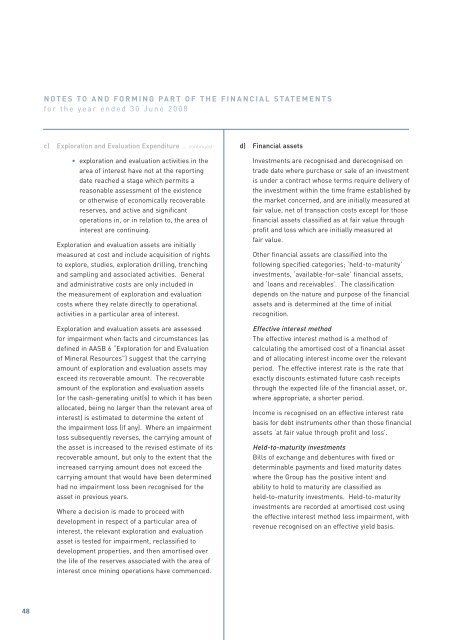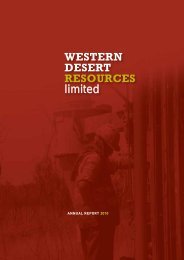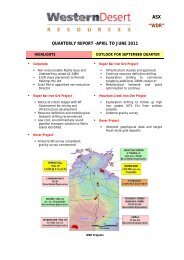view - Western Desert Resources
view - Western Desert Resources
view - Western Desert Resources
Create successful ePaper yourself
Turn your PDF publications into a flip-book with our unique Google optimized e-Paper software.
WESTERN DESERT RESOURCES LIMITED ABN 48 122 301 848<br />
NOTES TO AND FORMING PART OF THE FINANCIAL STATEMENTS<br />
for the year ended 30 June 2008<br />
c) Exploration and Evaluation Expenditure ... continued<br />
• exploration and evaluation activities in the<br />
area of interest have not at the reporting<br />
date reached a stage which permits a<br />
reasonable assessment of the existence<br />
or otherwise of economically recoverable<br />
reserves, and active and significant<br />
operations in, or in relation to, the area of<br />
interest are continuing.<br />
Exploration and evaluation assets are initially<br />
measured at cost and include acquisition of rights<br />
to explore, studies, exploration drilling, trenching<br />
and sampling and associated activities. General<br />
and administrative costs are only included in<br />
the measurement of exploration and evaluation<br />
costs where they relate directly to operational<br />
activities in a particular area of interest.<br />
Exploration and evaluation assets are assessed<br />
for impairment when facts and circumstances (as<br />
defined in AASB 6 “Exploration for and Evaluation<br />
of Mineral <strong>Resources</strong>”) suggest that the carrying<br />
amount of exploration and evaluation assets may<br />
exceed its recoverable amount. The recoverable<br />
amount of the exploration and evaluation assets<br />
(or the cash-generating unit(s) to which it has been<br />
allocated, being no larger than the relevant area of<br />
interest) is estimated to determine the extent of<br />
the impairment loss (if any). Where an impairment<br />
loss subsequently reverses, the carrying amount of<br />
the asset is increased to the revised estimate of its<br />
recoverable amount, but only to the extent that the<br />
increased carrying amount does not exceed the<br />
carrying amount that would have been determined<br />
had no impairment loss been recognised for the<br />
asset in previous years.<br />
Where a decision is made to proceed with<br />
development in respect of a particular area of<br />
interest, the relevant exploration and evaluation<br />
asset is tested for impairment, reclassified to<br />
development properties, and then amortised over<br />
the life of the reserves associated with the area of<br />
interest once mining operations have commenced.<br />
d) Financial assets<br />
Investments are recognised and derecognised on<br />
trade date where purchase or sale of an investment<br />
is under a contract whose terms require delivery of<br />
the investment within the time frame established by<br />
the market concerned, and are initially measured at<br />
fair value, net of transaction costs except for those<br />
financial assets classified as at fair value through<br />
profit and loss which are initially measured at<br />
fair value.<br />
Other financial assets are classified into the<br />
following specified categories; ‘held-to-maturity’<br />
investments, ‘available-for-sale’ financial assets,<br />
and ‘loans and receivables’. The classification<br />
depends on the nature and purpose of the financial<br />
assets and is determined at the time of initial<br />
recognition.<br />
Effective interest method<br />
The effective interest method is a method of<br />
calculating the amortised cost of a financial asset<br />
and of allocating interest income over the relevant<br />
period. The effective interest rate is the rate that<br />
exactly discounts estimated future cash receipts<br />
through the expected life of the financial asset, or,<br />
where appropriate, a shorter period.<br />
Income is recognised on an effective interest rate<br />
basis for debt instruments other than those financial<br />
assets ‘at fair value through profit and loss’.<br />
Held-to-maturity investments<br />
Bills of exchange and debentures with fixed or<br />
determinable payments and fixed maturity dates<br />
where the Group has the positive intent and<br />
ability to hold to maturity are classified as<br />
held-to-maturity investments. Held-to-maturity<br />
investments are recorded at amortised cost using<br />
the effective interest method less impairment, with<br />
revenue recognised on an effective yield basis.<br />
48






